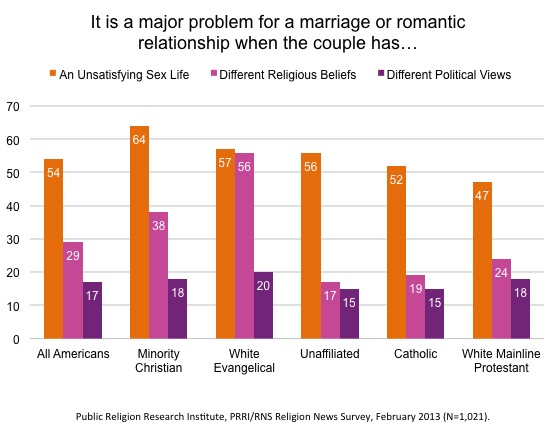Strong Gender Divisions in How Americans Plan to Spend Valentine’s Day
I. Who’s Celebrating Valentine's Day?
More than 6-in-10 Americans report that they are very (40%) or somewhat (23%) likely to celebrate Valentine’s Day this year. More than one-third (35%) say they are not too likely or not at all likely to celebrate the holiday.
Americans in new relationships are more likely to say they will celebrate Valentine’s Day than those in more established relationships. Six-in-ten (60%) Americans in relationships that are less than 2 years old say they are very likely to celebrate Valentine’s Day, compared to only 45% of Americans who are in 20+ year relationships.
Most Americans who are celebrating Valentine’s Day are not spending a significant sum to mark the holiday. Nearly half (49%) say they are spending less than $50, including 6% who say they won’t spend anything. Roughly 3-in-10 (29%) Americans report that they will spend modestly ($50-$100), while 1-in-5 (20%) will spend over $100.
Among Americans celebrating Valentine’s Day, men are planning to spend significantly more than women. Nearly 3-in-10 (28%) men are planning on spending at least $100, compared to 11% of women. More than 6-in-10 (61%) women say they will spend less than $50.
II. What Are Americans Doing on Valentine’s Day?
Going out to dinner is the most commonly cited likely activity for Valentine’s Day. A majority (54%) of Americans say that they are very or somewhat likely to go out to dinner. Nearly half (47%) say they are very or somewhat likely to have sex on Valentine’s Day. More than 4-in-10 (42%) say they are very or somewhat likely to go to bed early, while one-third (33%) say they are very or somewhat likely to watch a romantic comedy.
There are substantial differences by gender. Men (57%) are much more likely than women (37%) to say that they are very or somewhat likely to have sex on Valentine’s Day. Men (60%) are also more likely than women (47%) to say they are somewhat or very likely to go out to dinner. Men are, however, about equally as likely as women to say that they are very or somewhat likely to go to bed early (42% vs. 41%) or watch a romantic comedy (29% vs. 35%) on Valentine’s Day.
There is also a significant gender gap among married men and women. Nearly two-thirds (65%) of married men say they are very or somewhat likely to have sex on Valentine’s Day, compared to less than half (43%) of married women.
A majority (57%) of religiously unaffiliated Americans, a slim majority (51%) of Catholics, and nearly half (48%) of white evangelicals say they are likely to have sex on Valentine’s Day, compared to 4-in-10 (40%) white mainline Protestants.
III. Connection Between Sex and Valentine's Day Activities
Overall, men are more likely than women to predict that they will have sex in addition to other Valentine’s Day activities.
At least 7-in-10 men who say they are somewhat or very likely to go out to dinner (75%) or watch a romantic comedy (73%) on Valentine’s Day also say they are somewhat or very likely to have sex.
By contrast, fewer women who say they are very likely go out to dinner (50%) or watch a romantic comedy (41%) say they are somewhat or very likely to have sex.
There is also a significant relationship between the amount Americans predict they will spend celebrating Valentine’s Day and the likelihood of having sex. Among Americans celebrating Valentine’s Day, more than 6-in-10 (61%) of those who are spending at least $100 say they are very likely to have sex on Valentine’s Day, compared to 41% of those spending between $50 and $100, and one-quarter (25%) of those spending less than $50.
IV. America’s Relationship Status
Nearly half (48%) of Americans are married, while 1-in-10 (10%) are living with a partner. Sixteen percent of Americans report that they are currently in a romantic relationship but not married or living with a partner, and more than 1-in-4 (26%) say they are not in a relationship.
Millennials (age 18-29) and seniors (age 65 and older) are most likely to say they are not in a romantic relationship (35% and 34%).
Self-identified liberals (46%) are also more likely than conservatives (25%) to be single. Half (50%) of liberals are either single or in relationships that are less than two years old, compared to less than one-third (32%) of conservatives.
More than one-third (35%) of Americans who are currently in a relationship say they met their spouse or partner through friends and family. Roughly 1-in-5 say they met their spouse or partner at work (18%) or at school (17%). Less than 1-in-10 report that they met their spouse or partner at a bar or nightclub (8%), at church (6%), around their community or in their neighborhood (5%), or online (4%).

V. Relationship Pitfalls: Sex, Religion, and Politics
Americans are substantially more likely to say that an unsatisfying sex life is a major problem for a relationship or marriage, rather than differing religious or political beliefs. A majority (54%) of Americans say that an unsatisfying sex life is a major problem for a marriage or romantic relationship, while 24% say it is a minor problem, and only 15% say this is not a problem. Less than 3-in-10 (29%) say that having different religious beliefs is a major problem for a couple, while less than 1-in-5 (17%) say that having different political beliefs is a major problem.
Men (61%) are more likely than women (48%) to say that an unsatisfying sex life is a major problem.
Republicans (38%) are more likely than Democrats (22%) and Independents (29%) to say that having different religious beliefs is a major problem. Republicans (25%) are also more likely than Democrats (13%) and Independents (15%) to say having different political beliefs poses a major problem for couples.
White evangelical Protestants (56%) are more likely than minority Christians (38%), white mainline Protestants (24%), Catholics (19%), and the religiously unaffiliated (17%) to say that having different religious beliefs is a major problem for a relationship or marriage.
White evangelical Protestants are as likely to say religious differences constitute a major problem for a marriage or romantic relationship (56%) as they are to say that an unsatisfying sex life is a major problem (57%). Other religious groups are more likely to say an unsatisfying sex life is a major problem than differing religious beliefs.
Recommended citation:
Jones, Robert P., Daniel Cox, and Juhem Navarro-Rivera. “Strong Gender Divisions in How Americans Plan to Spend Valentine’s Day.” PRRI. 2013. http://www.prri.org/research/february-2013-prri-rns-survey/.





